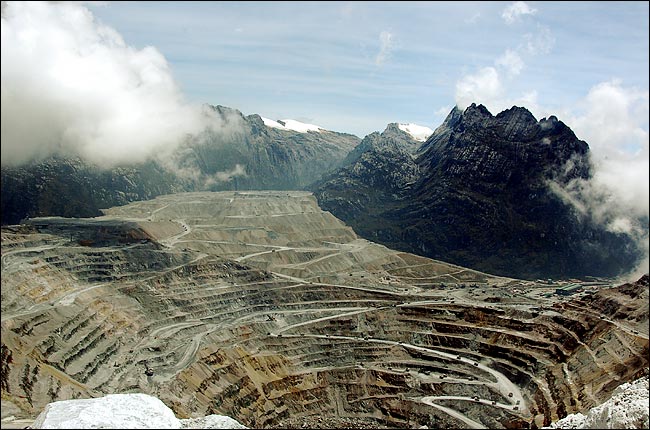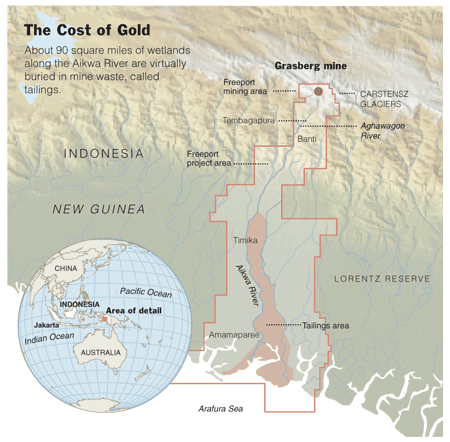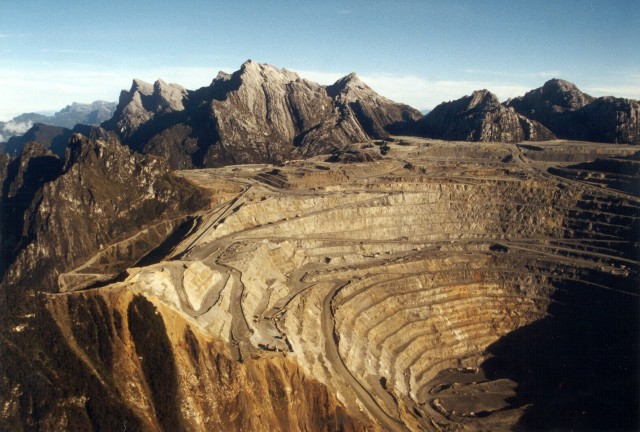There’s a huge new article in The New York Times about gold mining in Papua New Guinea and “the intricate web of political and military ties” that keep it moving.
 [Image: “Freeport-McMoRan Copper and Gold, an American company, operates this mine in the easternmost province of Indonesia, on the island of New Guinea.” Courtesy of the New York Times].
[Image: “Freeport-McMoRan Copper and Gold, an American company, operates this mine in the easternmost province of Indonesia, on the island of New Guinea.” Courtesy of the New York Times].
As the article describes it, the Freeport-McMoRan mine is like a dizzying combination of the novels of J.G. Ballard, Fritz Lang’s Metropolis, and a Werner Herzog film: “Freeport has built what amounts to an entirely new society and economy, all of its own making. Where nary a road existed, Freeport, with the help of the San Francisco-based construction company Bechtel, built virtually every stitch of infrastructure over impossible terrain in engineering feats that it boasts are unparalleled on the planet.”
The result is “a 21st-century version of the old company town, built on a scale unique even by the standards of modern mega-mining.”
It’s a geotechnician’s utopia – populated by construction engineers, former CIA operatives, and Indonesian military attachés.
 In the process, Freeport has literally created a new landscape, a down-river hydrological earthworks sculpture made entirely of poisonous mine tailings.
In the process, Freeport has literally created a new landscape, a down-river hydrological earthworks sculpture made entirely of poisonous mine tailings.
By “Freeport’s own estimates,” we read, the mine “will generate an estimated six billion tons of waste before it is through – more than twice as much earth as was excavated for the Panama Canal. Much of that waste has already been dumped in the mountains surrounding the mine or down a system of rivers that descends steeply onto the island’s low-lying wetlands.”
Incredibly, “the waste rock in the highlands, 900 feet deep in places, now covers about three square miles.” It is “accumulating at a rate of some 700,000 tons a day.”
At that rate, a whole new continental plate could be created.
 [Image: A view of the mine, by Kutztown University geologist Kurt Friehauf].
[Image: A view of the mine, by Kutztown University geologist Kurt Friehauf].
Another danger, however – though I find this fascinating – is that “the waste rock atop the mountain will trickle out acids into the honeycomb of caverns and caves beneath the mine in a wet climate that gets up to 12 feet of rain a year.”
Before my morals kick in, I’m left stunned by a vision of technicolor stalactites growing drip by drip in the darkness, stretching toward pools of iridescent pollution slowly solidifying into rock. What, in a million years, will these caves look like? Will anyone be around to spelunk them?
Could you deliberately use metallic pollution to color rocks, then use those rocks as a building material?
Bank lobbies floored with examples of a new geology. Using caves as a kind of rock-farm; harvesting for color.
In any case, the article is totally fascinating, whether it moves you to campaign against pollution or invest in gold mine companies; and there are two prequels to it, as well: here and here.
(See also BLDGBLOG’s Monitor Mine, Bingham Pit, Utah, and the World’s largest diamond mine, as well as some cool limeworks photographs).